Written Document
The 3D Digital Play Environment:
Using Depth to Create a Narrative
Table of Contents
Abstract
Introduction
- About the Research
- Scope and Limitations Overview of Document
Literature Review
- Evolution from 2D to 3D Work
- The 3D Digital Film
- Application
- Critical Play: Designing the Unique Play Environment
- Performing Dada
- Surrealist Game
Contextual Review
- Team Lab: "Future World: Where Art Meets Science"
- Relations
- Demonstration
- "Dreams of Dali: 360-Degree Video"
- Relations
- Demonstration
- "Van Gogh: The Immersive Experience"
- Relations
- Demonstration
Methodologies
- Mechanics: Description of Elements of My Project
- Narratives: What I Want to Deliver
- The Surrealist Digital Illustration
- The 3D Digital Environment
- The Collage Video
- Aesthetic: Description of the Goal of My Project
- Dynamics
- Application of Contexture Reviews
- Application of Literature Reviews
Outcomes and Reflection
Future Directions
- Applying Contextual Review
- Applying Literature Review
- Surrealists and Performance
- Virtual Reality
Bibliography
Abstract
The research is about making a 3D digital playing environment where the artist can narrate his perspective on the critical aspects of human life. The Parallax Effect for the Digital 3D Cinema inspires the artist to use a property of depth to direct an emotional evoke from the work's foreground toward a particular situation depicted in the background. In the foreground, he uses the collage video, which shows his perspective on the critical aspect of human life through his personal experience. His narrative develops into the 3D environment by using "critical play," a design theory introduced by Mary Flanagan, to build his narrative unique play environment. The Surrealist game inspired him to create an ironic connection between the superposed mechanics of his surrealist drawing and collage video. The surrealist drawing is about his unconscious mind, which shows his identity and the four seasonal features of life. The collage video shows his personal experience to explain why he thinks the pain is like a winter season and how he endures the hardships within his journey. The realistic scene of the video and the surrealistic scene of the picture contrast and build ironic relations in the depth of the picture. He simulates a projection mapping and projects his drawing on all sides of the wall inspired by "Van Gogh: The Immersive Experience." "Dreams of Dali: 360-Degree Video" is a significant example of creating a surrealist exploration using 2D surrealist drawing. His research is to develop effective delivery of the narrative through the exploration in the 3D drawing, and the performances are going to be on his next project. One of the contextual reviews, "Future World: Where Art Meets Science," is going to be a suitable example for him to create back-and-forth interactions creatively by using computational coding.
Introduction
About the Research
The personal project, "The Surrealistic Camellia World: My Unconscious Mind" (2023), summarizes my academic journey of what and how I want to communicate as an artist before I immerse myself in the professional Industry. I have gotten into the artistic journey with drawing and painting, but I have felt the limitation of having passive communication through the work. Innovative digital technology has helped me expand the limitations, so I wanted to focus on the 3D digital space as my research area to understand its potential. Based on the contextual review, I have simulated the projection mapping to transform my 2D surrealist drawing into 3D space using the 3D game development platform. Literature Review has taught me how to use depth to narrate my critical aspect of human life by effectively building the connection between mechanics. I have gone through this process to find out if the audience can understand the narrative better through the exploration within the 3D space than viewing the projected work on a 2D surface.
Scope and Limitation
The limitation of the research is about the sensation through interactive performance and social influence. My ultimate goal is to build an expressive work in which I can create real-time back-and-forth interactive communication where players can be involved and transform the work while they are exploring in another reality. However, I first need a working area to build that interactivity. Therefore, my scope is 3D space and narrative by creating the connections between mechanics through displacement.
Literature Review
Even though I have started my journey with drawing and painting, I have moved into the installation work and developed it further by learning innovative digital technology. My project summarized all my learning progress before I got immersed in the industry. Hence, the research has started with understanding why I chose to work with a three-dimensional environment rather than two dimensions. Understanding the property of three-dimensional art and its potential from the usage of depth can give me insight into why using depth is more advantageous to reaching my ultimate goal of breaking the communication barrier between me and the audience. I took the literature review further by learning about the historical journey of Dadaists' use of space as a critical play under surrealism. They have expressed their crucial aspect into their play environment to step further toward as a future artist.
Evolution from 2D to 3D Work
As technology develops, artists have found more possibilities to craft and present their works in various ways. The works on a flat surface can now presented in a three-dimensional way with depth for a more realistic sensory experience. The film has been an excellent example of those evolutionary processes. Kristen Whissel's "Parallax Effects: Epistemology, Affect and Digital 3D Cinema" has researched how digital 3D film creates the illusion of depth. The study has guided my working process of creating a three-dimensional digital environment by understanding the strength and importance of three-dimensional spacious work with effective communication.
The 3D Digital Film
When we watch a 3D film, we have to wear 3D viewing glasses with red and blue lenses on the left and right sides of the glasses. When a viewer sees a "stereoscopic 3D image" through the glasses, they can see the illusion of the objects appearing on the front and back of the screen. The object on the back of the screen is "positive parallax." It makes a desire to see and know, called "epistemic seeing." The illusion on the front of the screen is "negative parallax."
The "negative parallax" is for "affective seeing." It means the popped-out image gives a sensational experience that works like a focal point by highlighting certain emotions and sensations for smooth communication where everyone can be on the same page. Those two elements create a movement with the viewer's viewpoints since negative parallax "provokes somatic and emotional responses" as a focal point, and they shift their view toward positive parallax since it "promotes a curious look that sees in order to know" what is on the back." This process flows forward to backward, eventually creating a sense of depth (235, Whissel).
Application
It is interesting to see how filmmakers overlap two scenes from the left and right-sided views to create emergent images. Their silhouette creates the illusion of depth with the help of the 3D viewing glasses because of the emergence. Emergence is the ability to recognize the meaning of a whole by gathering information from meaningless pieces into one. It backs up my plan of putting random objects and media which are unexpected but still relate to the narrative of the background surrealist picture for me to create an ironic mood under surrealism. Emergence can enable them to put together all the different puzzle pieces in the foreground when they see the background later to understand the whole meaning.
The reading also shows me why I should work in 3D rather than 2D. It describes 3D's ability as "a dream-like exaltation of the faculties." It means "we seem to leave the body behind us and sail away into one strange scene after another into pleasurable and productive tension with the illusory solidity and tangibility that 3D gives" (238). In other words, 3D can offer an immersive experience by "cheating the senses" for the sensory experience. It proves that the research of transforming 2D surrealist pictures in a three-dimensional way is meaningful to achieve an immersive and dreamy aesthetic to highlight the surrealism of the drawing.
Critical Play: Designing the Unique Play Environment
Mary Flanagan's book "Critical Play: Radical Game Design" has built a fundamental knowledge of using space for communication and social influence. Flanagan has suggested critical play as a game design theory to produce a play environment based on "critical aspects" of human life. For this project, I narrate that the hard times in our lives are not eternal, so if we keep on our unique journey and overcome the hardships, the painful experiences can strengthen us. My aspect has developed as a narrative, and I build the connections between elements based on the narration to create a narrative 3D Digital Space.
Performing Dada
Learning a historical journey is essential before we decide since we can use the past case as a reference. For this project, I am presenting it in a game form, and "several scholars and curators have noted the Dada movement's influence on interactive art, its influence on gaming." They have considered how they can communicate through their work performance as "a reaction that valued creativity over violence and social upheaval." Dadaists initially wanted "a complete break with tradition" and wrote a new paradigm to replace the old culture of ruling the society with "the horrors of a world war." Now, we are living in a world without war or fear. The artist has more freedom and spare time to focus on the work they enjoy because of their ancestor's effort. However, we still need to explore further to break the new cultural issues like how Dadaists used to fight with the horror of war (153 Flanagan).
Surrealist Game
Dadaists enacted the horror of war with their creative design practice of approaching the human mind. Surrealism, a psychoanalysis of the unconscious mind, dissolved into their practice because critical play is also to "start with the workings of the human mind." The Surrealist games originated "based on activities as familiar as Victorian-era parlour games." It was the indoor group explorative activity in the surrealist space. I adopted the surrealist game's play environment element because my project was about expanding the 2D surrealist drawing into a 3D environment using digital technology.
Historically, they also placed a series of drawings to create " a hallucinatory series of contradictory images rose before viewer's eyes." It establishes a surprisingly ironic atmosphere. I also tried to build ironic connections between the different elements within the 3D spaces by superposing themselves one upon the other. Previously, they superposed those layers of images to create a 3D illusion. However, I used the elements to effectively use the depth of the space since the presentation already happened in a three-dimensional game (156).
Contextual Review
Team Lab: "Future World: Where Art Meets Science"
"Team Lab" has been my first contextual review because it has significantly influenced my journey of developing the installation work using digital technologies. It is a group of "ultra-technologists" working in a flexible, multidimensional structure that aims to "achieve a balance between art, science, technology and creativity." They are making an "immersive-reality experience" within their performative digital environment that everyone can enjoy. They blend digital projection technology, projection mapping, optical sensors, computer programming, and artistic vision to create vast visual fields on walls, ceilings, floors, objects, or entire buildings. It will be interesting to see how they use digital technology to expand the possibility of communication by making the work reactive with its performativity. "The existence and behaviour of the viewer can influence the art, thereby blurring the line between art and viewer."
Relations
I have chosen their work because they presented a harmonized digital environment. They strongly influence the wide range of targeted audiences and affect my goal of creating inclusive space. I want to analyze their dream-like world for the expression of surrealism. I can also learn their method to provide a unique custom-made experience as people explore the work under the aesthetic goal of sensation and expression.
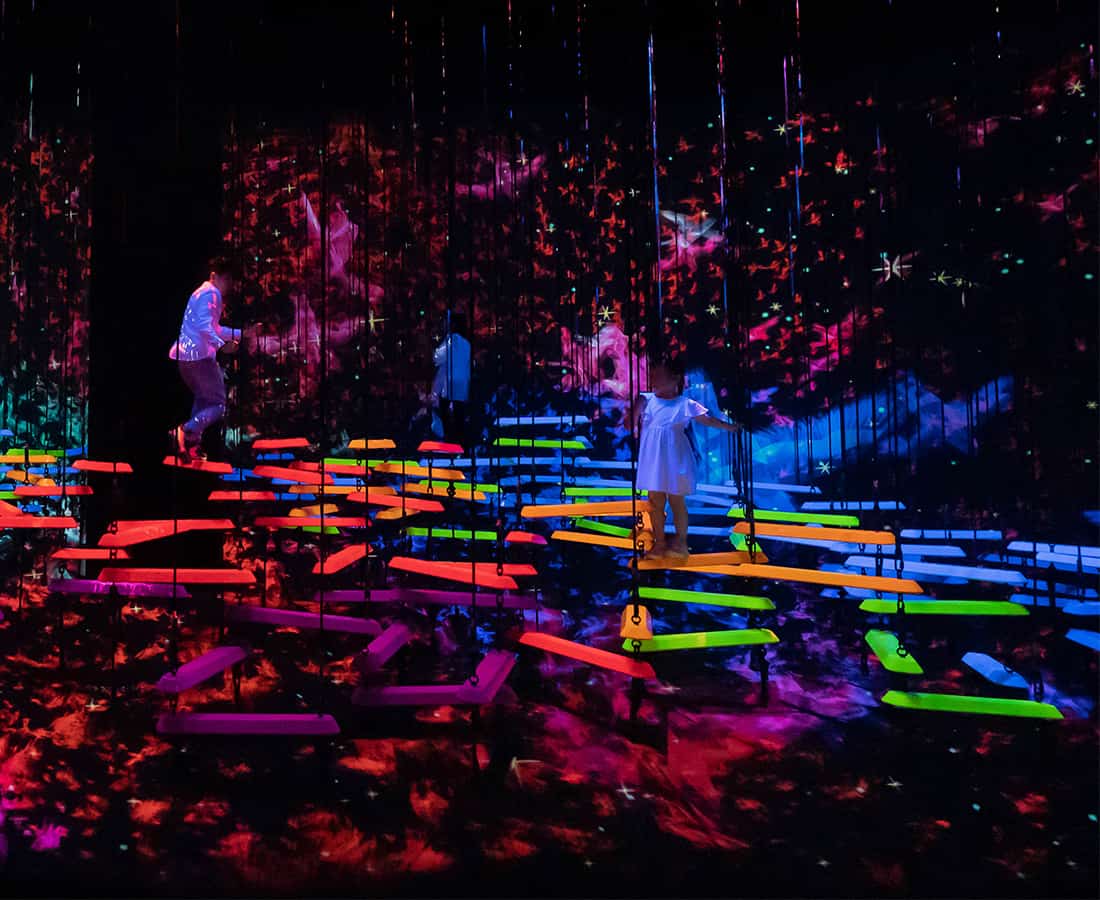
Demonstration
Out of their many exhibitions, I have specially chosen to research "Future World: Where Art Meets Science." The show has integrated computer science and the creative world into creative coding to produce the reactive shader as a back-and-forth communication. For example, when audiences have scanned their physical drawing, it is transmitted over a network and appears remotely on the 360-degree LED touch screen. The screen covers the entire walls of the space, so it tricks people's senses, which makes them think they are in the digital world. The team offers people an immersive experience by mixing art and scientific technology.
People can use their smartphone application to control their scanned drawings. The player can control their drawn object in real time because of the interconnection between the screen and the application. The screen and smartphone project the same space from different viewpoints. The detective screen shows the entire metaverse, and players can see and control the character through a camera with a third-person view.
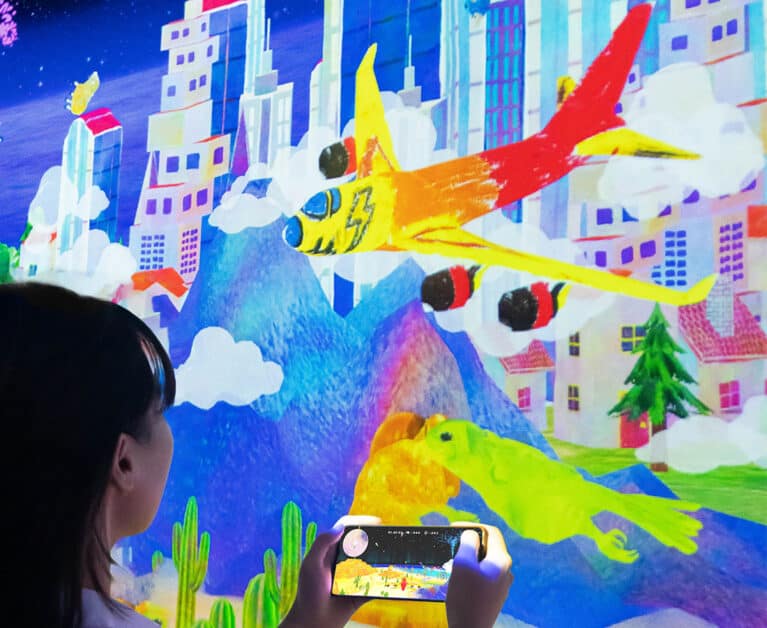
There is one more room that has captured my interest. When audiences touch and drag the screens on the walls, they can swipe the circular particles on the screen. The creative coding creates a circular motion of the particles based on the audience's motion capture through sensors. The natural movement based on humans' non-geometrical activity creates a beautiful scene. Its rhythm and harmony within the variety give a visual impact, which leaves an aftertaste.

"Dreams of Dali: 360-Degree Video"
"Dreams of Dali: 360-Degree Video" uses VR technology to create an immersive environment where audiences can explore the surrealistic world, which has developed based on his painting Archaeological Reminiscence of Millet's "Angelus." Millet's couple transformed Dali's painting, which he drew while attending an elementary school. It was about his invented stories of the peasant couple praying in the middle of a potato field. They changed it into an "ancient, gigantic sculptural ruin in a barren landscape illuminated by the moon" under a surrealistic mood. It is a cinematic work, so "viewers cannot control the experience but are free to look in any direction they like" (Pangburn).
Relation
It is interesting how they implement the 3D world based on the narrative of the two-dimensional painting. I am also trying to create depth in my work. I want to expand the space because I want more freedom of expression by enabling me to add the details from various angles. There is more potential to expand the space into a world to offer an adventurous experience to the audience like this work of art. Creating more depth can offer audiences more time and steps to understand the piece. I have learned the new potential of VR and digital space since the artist can use all the angles for their works rather than presenting in a fixed position. Furthermore, making it a reactive work with its interactivity also gives me insight into my following research to create a more significant influence by personalizing their experience.
Demonstration
When audiences immerse themselves in the digital world, they can "venture into the towers, peer from them to distant lands and discover surprises around every corner." If the painting illustrates the silhouette of the external look of the tower, 3D cinematic work offers more possibilities by letting audiences tour inside. The benefit of this presentation is that it is not a one-sided communication. Audiences can explore desirably and learn through the experiences from a process journey. The delivery is more prosperous because they can have their unique experience rather than receiving a nicely refined message based on the artist's perspective. Furthermore, they also use interpassivity in a specific geographical area of the metaverse, which makes audience exploration more meaningful by intentionally creating a focal point to the point they want to highlight for the clarity of the delivery.
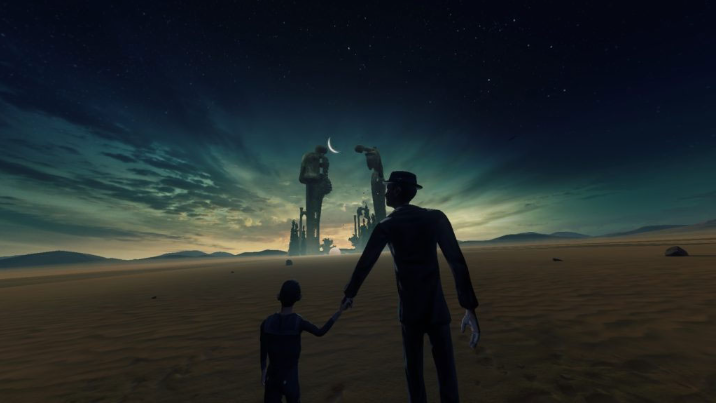
"Van Gogh: The Immersive Experience"
Van Gogh: The Immersive Experience is an exhibition of Vincent van Gogh's paintings in an immersive space. Audiences can sense that they are exploring the inside of the picture with their projection mapping onto walls, ceilings, and floors. They create more variety with animations, narrations, music, or fragrances. It offers a rich experience by providing a suitable viewing experience depending on the painting. People can walk around and be a part of the painting. They chose Van Gogh's painting because "people recognize the artist's vibrant colours and are intrigued by his story." First, people start the journey because of their interest in his solid visual presentation, and as they walk through it, they will understand and get into a deeper conversation.
Relation
This exhibition is another work of re-creating a 2D picture into a three-dimensional immersive environment. However, it used to project the drawings on all sides of the wall rather than re-creating the picture in the 3D world like the above work. If the above work has created a three-dimensional environment from the drawing, it has used the projection mapping skill to create depth in the picture. It opens my perspective of another way to create depth with the 2D work.
Demonstration
They consider the viewers' experience by guiding them to see the work differently depending on the drawing. For example, people can lie on the couch and watch the drawing on the ceiling, and some rooms have circular spots that ask them to stand in that position to see the work. Furthermore, they have created more depth in the picture by dissecting the works into different pieces, separating them in the back and foreground. The transition speed of Objects in the background is much slower and has less movement than in the foreground. It is an exciting way to trick the viewer's senses using the parallax effect. They can feel depth by contrasting the speed of the movement of the back and foreground of the picture.
Methodologies
Before directly crafting the project, I have to design the game first. MDA framework, which stands for "Mechanics, Dynamics, and Aesthetics," is a suitable formal approach since it "attempts to bridge the gap between game design and development." I need to know what I want to deliver to build particular components (Mechanics) to run them under a specific system (Dynamics). I also need to know what type of fun or experience (Aesthetics) I want to offer the player because the operating way (Dynamics) will change depending on the goal (Hunicke, LeBlanc, and Zubek 1). Therefore, my methodology is to design mechanic and aesthetic goals and then develop a game under a specific setting to run the game under the dynamics to reach the goal when I present the work.

Mechanics: Description of Elements of My Project
I have been presenting the same theme of representing my life by using the symbol of the camellia flower in various methods and technologies throughout my academic journey. I have wanted to establish my unique style by trying to communicate the same message in multiple ways to find the most effective and suitable way. All of those years of learning have become an influence on the final project. Based on what I have been doing, I want to re-organize my work in a new 3D digital space where I can present what I have been practising before I step further away to the new way. Therefore, I have chosen the mechanics from the processed journey and displayed them in a newly crafted mechanic of 3D digital space under the aesthetic goal, and I ran the work based on the research to produce specific effects.
Narratives: What I Want to Deliver
I have started my journey by finding my identity. I have needed to understand myself first to build my unique standard to continue my journey of influencing others with my work of art. I have looked into my childhood to see how I have been through the past. I have endured stormy hardships, and that experience eventually has fed me to grow stronger against more giant upcoming storms. The process seems like a camellia flower patiently going through the harsh winter to bloom its flower.
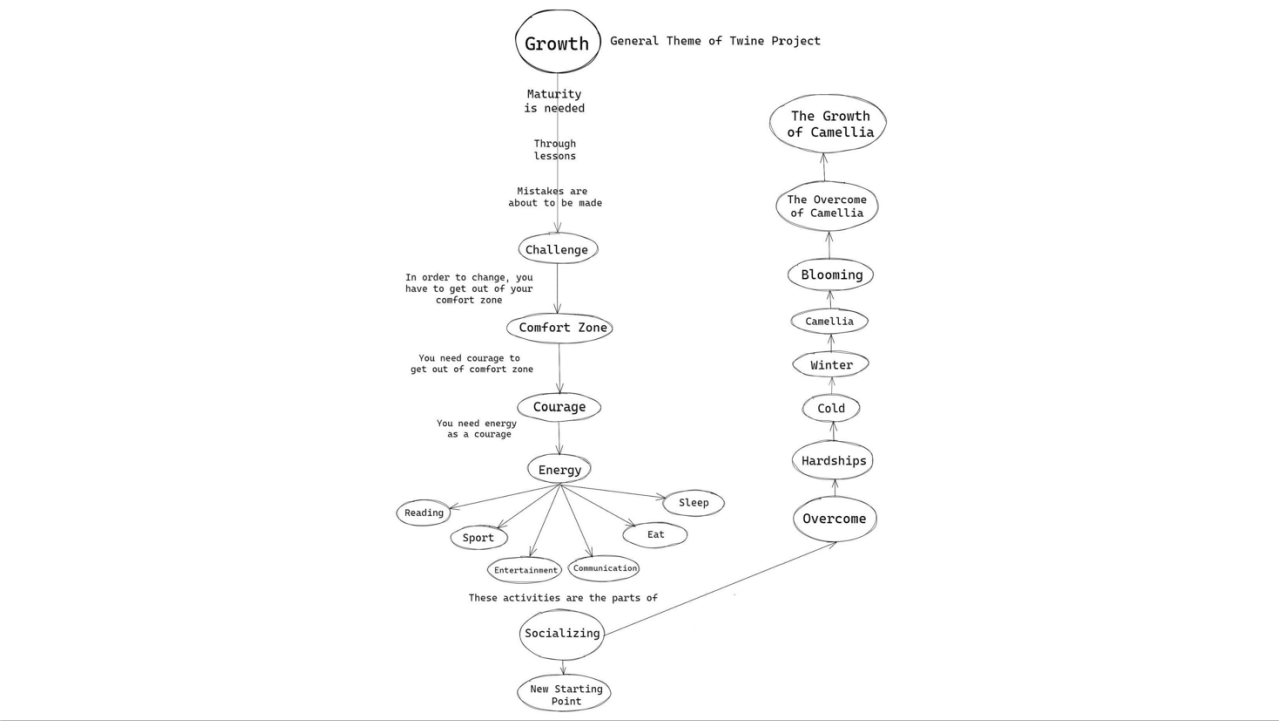
It has been interesting because of how ironic it has been to bloom the warmth within the cold. The contrasting properties of winter and the camellia tree influenced me to work with contrasting elements to build an ironic scene. Surrealism has been the best way to express irony and my identity, which have existed but been invisible simultaneously. I have delivered the image of my identity as a camellia flower to influence people not to give up and continue their unique journey for a more beautiful society with various dynamics within harmony.
The Surrealist Digital Illustration
I have been thinking of a way to materialize my identity in a presentable way. I have ended up drawing an image of my unconscious mind. My mind should be a spacious house where different sides of me can live in one place. Out of many rooms, I have decided to illustrate a bedroom. The bedroom has been the most personal area of the house to show someone's personality well.

The bedroom has a big camellia tree forest inside a small geometric room. The bedroom is where people get their energy from sleep, so I intentionally set the season as spring to indicate a space where I can start my bright day to prepare for the next season. There are some spring flowers, a germinated seed, and fallen camellia flowers from trees after the winter since it is the spring season. I have blended different human body parts into various elements to create a dreamy mood. I also desaturated the foreground tree compared to the saturated background to make the drawing more ironic by putting it in a different order for a more surrealistic mood.
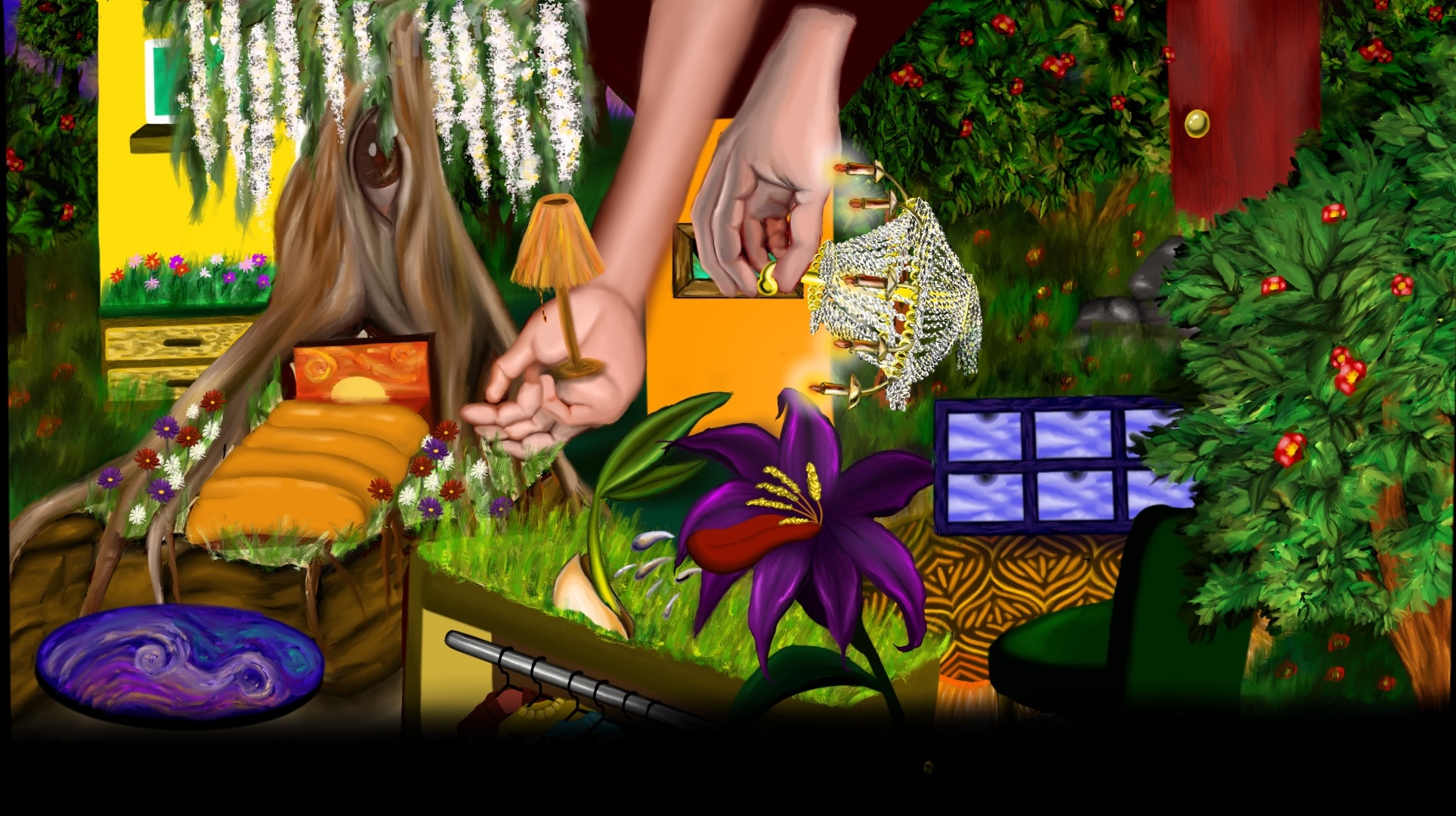
The 3D Digital Environment
The theme of the background narrative is growth through the journey. I wanted to highlight that motivational energy ironically comes from the growth after pain. I have been thinking about a space where I can express the theme. I have decided to make a captain's room inside the ship, which travels around my surrealistic unconscious world. I have added the story that the boat changes ironically due to the surrealist power of the core of my mind.
The Collage Video
I do not want to force anyone to change. Instead, we can create a social innovation by influencing others as a good representation. Our current society has become various, so we must find harmony with understanding and respect. Accepting differences can fill the gap of the differences. If all independents in society start to keep on their unique journey without being swayed by other people's thoughts, our society can naturally respect each others' standards.

I metaphorically narrate my identity as a camellia flower with my surrealist drawing, but I need more explanation of the reason. The element that mirrors our society can work as the back of reasoning, which can help players draw a complete picture. If I am a camellia flower which blooms its flower in the winter season, hardships like a cold snowstorm are an external source which appears in our society. Photo collage is one of the Dadaists' methods to raise the social wave by using it as a "technique mirroring," which depicts the societal issue from reality (Flanagan 154). A collage of the short videos describing my life in the new environment can build connections with our interdependent community.
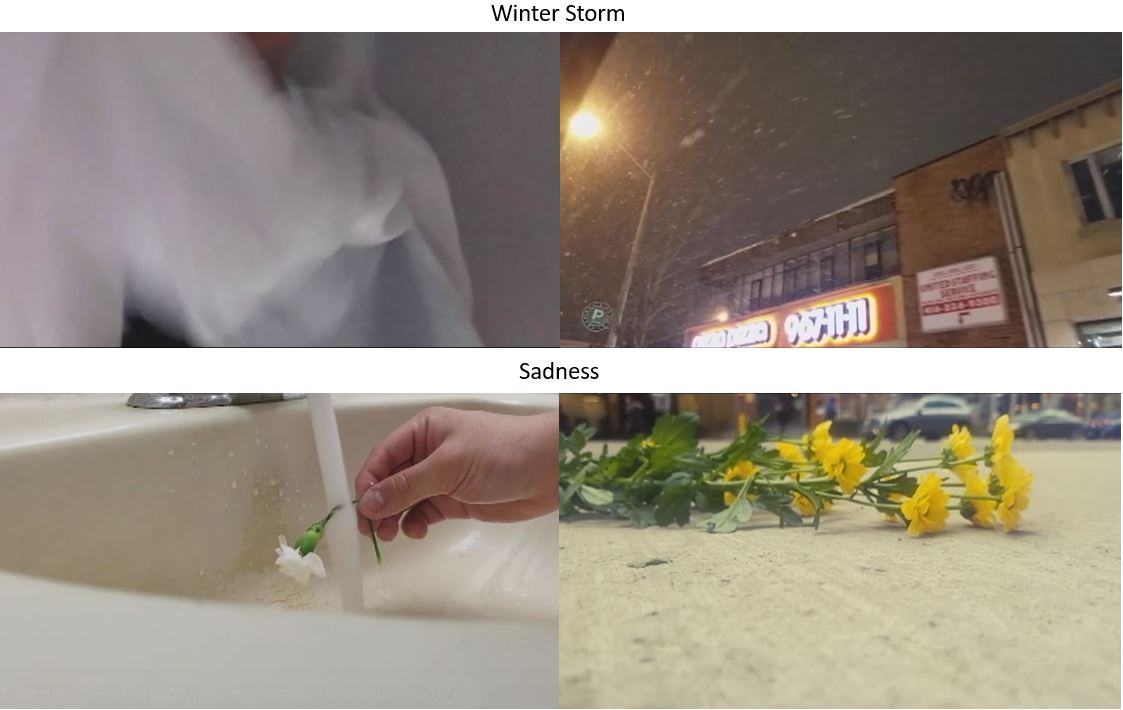
Aesthetic: Description of the Goal of My Project
Aesthetics is "the desirable emotional responses evoked in the player (Hunicke, LeBlanc, and Zubek 2). It is the purpose of the project. Game designers design the game based on the experiences they want to offer users. There are many different types of experiences game designers ultimately want to provide to people. Aesthetic vocabularies describe what types of experiences are the ultimate goal.
My ultimate aesthetic goal is "Expression: game as self-discovery." I want to create a societal influence through the exploratory journey of acquiring insight into our character because change needs to happen within us. We cannot force others in our desired way. Everyone has a different background and standards, and variety is necessary to make a more vibrant society. This variety comes from each other's unique journey, but we still need to harmonize the varieties with understanding and respecting differences.
However, this must happen step by step, so it needs three stages to create an expressive game. "The Surrealistic Camellia World: My Unconscious Mind" (2023) is the first step. It is a 3D digital space where I can achieve narrative as an aesthetic goal before I move on to the next stage, where I create a sensory experience through the performance of the piece. Narrative refers to a "game as drama," and the work narrates the drama of critical aspects of my life. I deliver my learning that pain is not eternal and that pain can bloom our potential based on my personal experience.
We might go through problematic situations, but I want to highlight that pain ironically strengthens us. It is because of a wish for everyone to continue their unique journey. There also might be a current societal issue because of the too much variety, like my surrealist world. However, if we patiently wait till the end of the winter, we can see that those varieties make our world even more beautiful through harmonization.
The sub-element of the aesthetic goal of the project is Fantasy. A fantasy background setting makes the player accept the narration through the surrealistic presentation. The background story is the ironic transformation of the captain's room because of the surrealist power of my unconscious mind. My life experiences have unconsciously created a dreamy world, so players can see the illustration, which narrates my story by visualizing myself as a camellia flower. There are areas where the players can see our society from my perspective.
The current project is a fundamental base for building an interactive performance to create a "game as sense-pleasure." It is a thriving space that narrates my perspective. Yet, I still need to develop the digital environment as an immersive environment. I plan to create immersive experiences from realistic sensory experiences through interactive performances. I will continue my journey to be an influential artist by offering a space where people can discover themselves at the end.
Dynamics
Dynamics describes "the run-time behaviour of the mechanics acting on player inputs and each others' outputs over time" (2). It talks about the functionality of the game. The contexture reviews are excellent examples of how professionals create back-and-forth communication using mechanics to accomplish the aesthetic goal. I have used these examples to start my journey by building my functional way to be an influential artist. I have reviewed the pieces of literature to check if there has been any previous related research to construct the work and take even further steps to continue the journey in my unique way.
Application of contexture Reviews
The key has been combining different mechanics into one cohesive piece to deliver a clear message. I have simulated projection mapping in a digital game by displaying two-dimensional drawings on all sides of the walls, like "Van Gogh: The Immersive Experience." "Dreams of Dali: 360-degree Video" has given me the idea of building a story based on the narrative of the painting to create a 3D world that players can explore. I have framed the surrealist drawing of the world of my unconscious mind inside the 3D environment of the captain's room. The unnatural way of ordering a big world in a small space creates an ironic mood that brings curiosity.
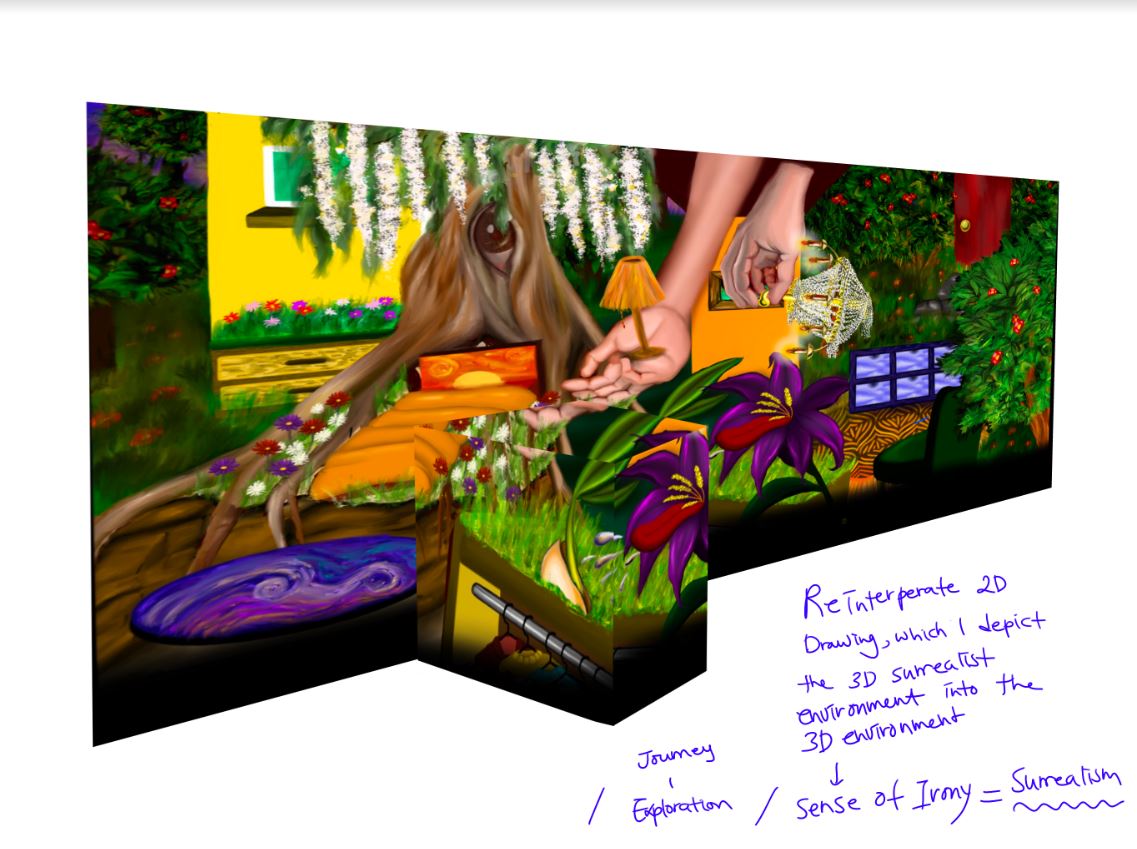
Application of Literature Reviews
When I build a communicative space, I connect foreground and background based on the parallax effect. The foreground of the space is furniture textured in the collage video. The collage video is an experimental video to create empathy for people to understand the pattern of our lives by seeing the world through my perspective. The background of the space is a surrealist drawing. The emotional response that happens in the foreground can apply when they are viewing the picture. I wanted the foreground to be an additional explanation of the drawing by finding the ironic connection between those two different elements.
When I built the 3D digital environment, I designed it based on the critical play because the narration was about my unique perspective on our lives. The surrealist game was my inspiration out of many different ways of creating a playable environment. I formed a surrealistic presentation with an ironic atmosphere. I can create depth in the space by crafting the 3D digital environment using technology, so I focused on making the contradictory connectivity between mechanics by superposing themselves one upon the other. Consequently, the collage of videos of realistic view superposed on a background surrealistic drawing. Ultimately, the ironic mood interests viewers and makes them want to investigate the narrative environment more.
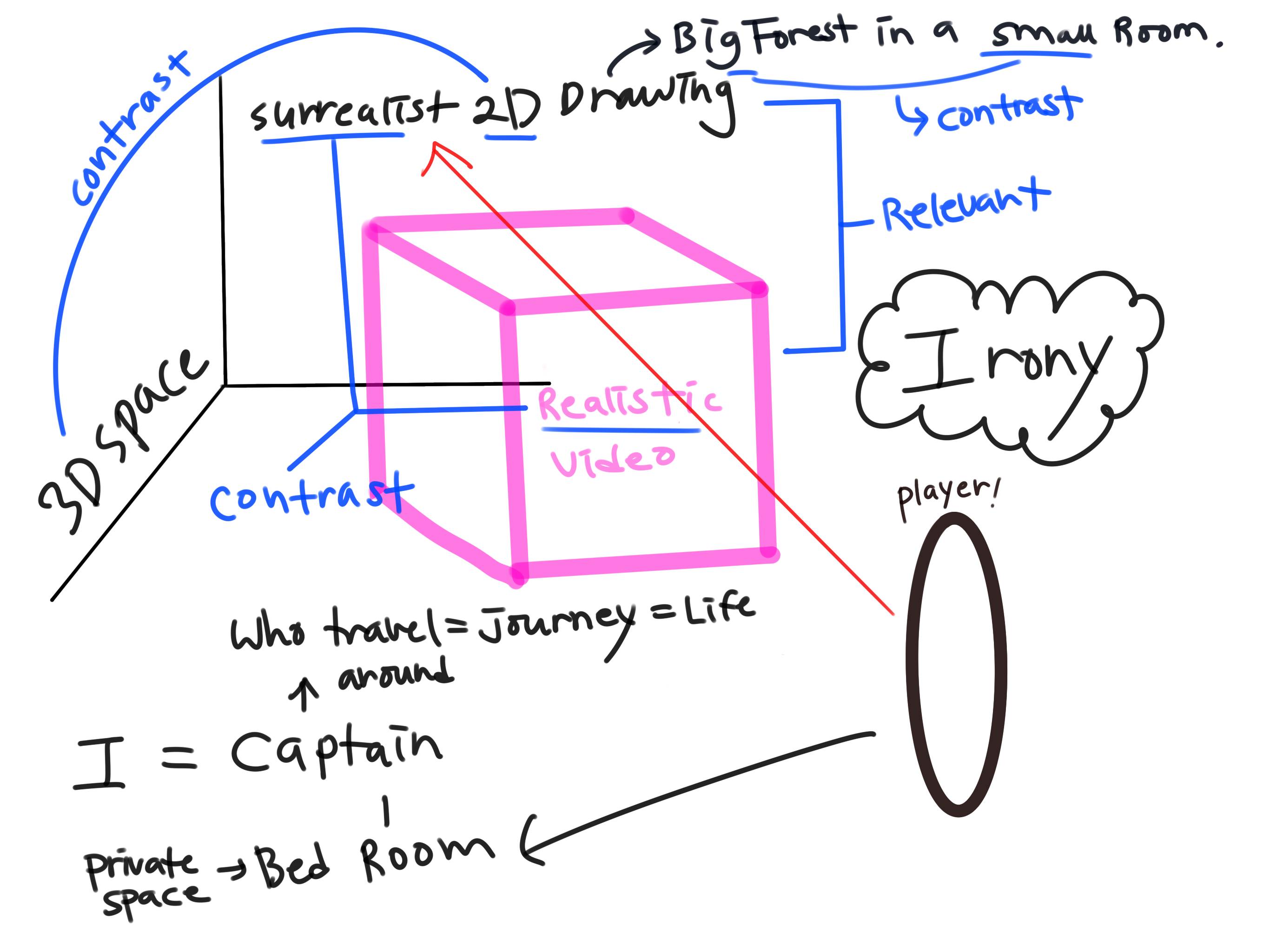
Outcomes and Reflection
During the presentation of my work, the first thing the player saw was snow falling and an umbrella. The ironic combination of those two elements brought his curiosity and expanded his interest in the whole environment setting of the space. The bright texture was the second thing that caught their eyes. I tried to harmonize various colours as I was crafting the pieces. When he continued his exploration, I got the comment that the collage video was driving an exciting connection with the artwork at the back.
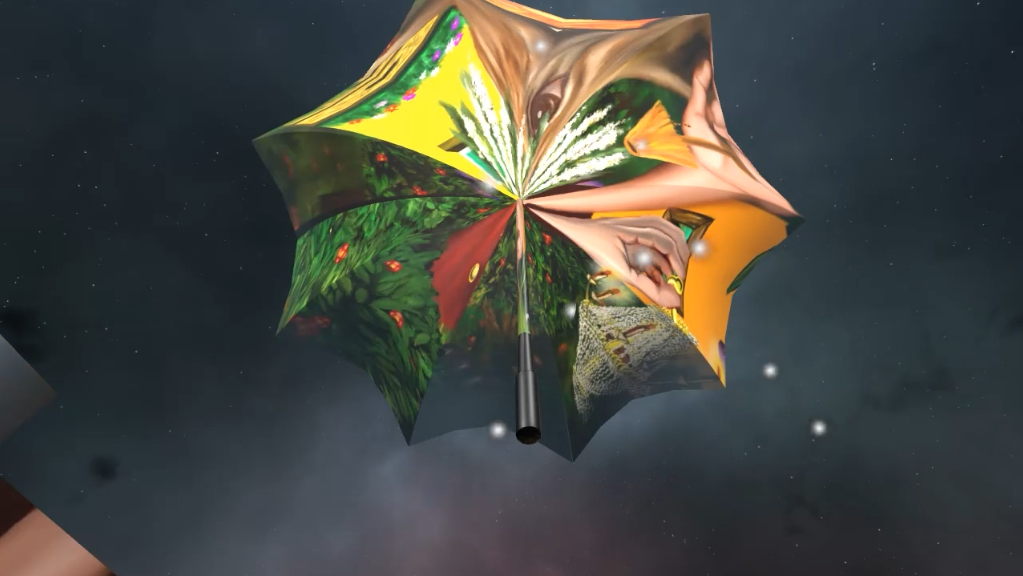
The player's reflection showed that the use of depth by displaying the video in the foreground and drawing at the back was successful. People felt the footage was experimental and made it personal. A scene that showed my face on the reflective glass table played around with the notion of identity by meaning to see me through the video. Lastly, floral imagery contrasted with the cityscape to create another ironic connection to think about the work's narrative.
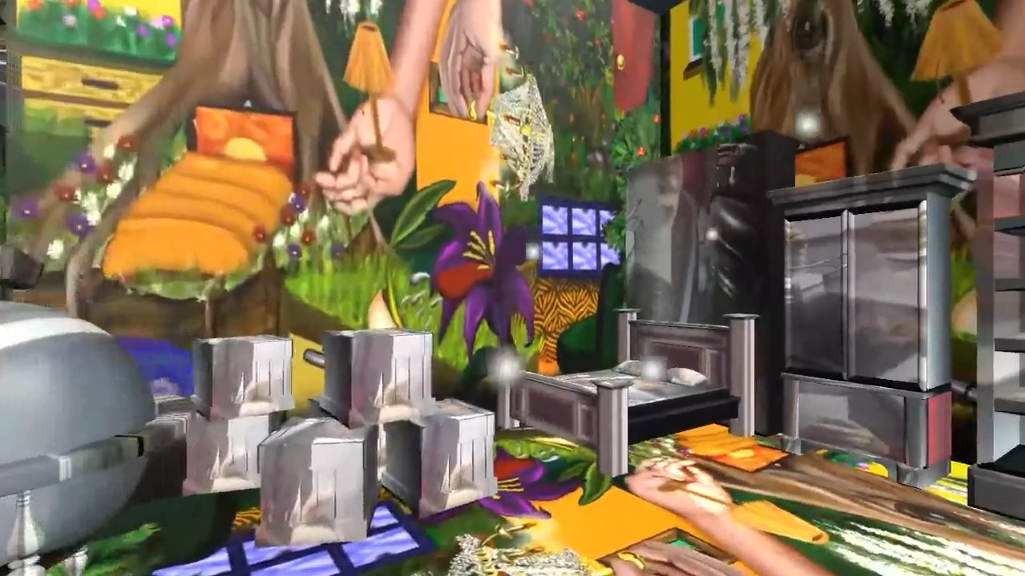
Future Directions
I have focused on creating a narrative 3D digital space for this project. I will use this work as a fundamental base to build up the performance within the space by using interactivity. The interactive performance will give a sensational experience to the audience as a process of building a smooth back-and-forth communication of expression of audiences and artists. This communication will help the audience self-discover by reaching the aesthetic goal of expression. Self-discovery is essential to create a change within oneself before the change expands to society through influencing one another.
Applying Contextual Review
Team Lab's "Future World: Where Art Meets Science" is an excellent example of creating interactivity using computational science for sensation. Their reactive work based on players' input using creative coding will be my primary influence in building back-and-forth communication. Team Labs' work gave me lots of inspiration. As my future step, the work might present its performance by transforming its shader on the walls or space by sensing the player's location or when they input an action using the mouse. It will be interesting to feel the player's actions and transform the work of art based on their responses to create more effective communication.
Applying Literature Review
Surrealists and Performance
My performance will aim to access the player's unconscious through organized procedures. It is the "cultural methods that brought meaning to the every day by altering participant relationships to the world through rule-based systems" (156). The environment with an interactive dynamic system will offer an open experimental exploration that emphasizes "the social and intellectual role of the community." The expression they will earn by exploring the depth will help them "understand the larger questions of consciousness and culture" (157). This process will allow them to draw a complete picture of the current society and find an effective way to find harmonization within the variety.
Virtual Reality
I can let players control the character and put an input action by using the keyboard or mouse. Still, I want to develop the exploration in a more realistic way to create an immersive environment through a lifelike sensory experience. However, I must find a way to cheat the senses to accept the digital space as another reality. I will use a VR camera to present the space as a virtual reality to give "its sense of presence" with "the responsive character of the environment" (Bolter 163). My goal in using a VR headset will be "the cyber-enthusiasts," hoping that "virtual reality can disappear as an interface and give the viewer the same emotions that she would feel in the real world" (165). It will make communication more effective since the work can evoke realistic emotions through the "self-authenticating experience." Ultimately, the sensation of playing themselves in another reality will help them build "the definition of the self and the relationship of the body to the world," effectively making the critical play environment narrate my perspective of an essential aspect of human life (166).
Bibliography
Bolter, Jay David, and Richard Grusin. “Virtual Reality.” Remediation: Understanding New Media, MIT Press, Cambridge, Mass, 2003, pp. 161–167.
Flanagan, Mary. “Performative Games and Objects.” Critical Play, MIT Press, Cambridge, Mass, London :, 2009, pp. 149–157.
Hunicke, Robin, et al. “ MDA: A Formal Approach to Game Design and Game Research.” Proceedings of the AAAI Workshop on Challenges in Game AI, vol. 4, 2004. 1.
Whissel, Kristen. “Parallax effects: Epistemology, affect and digital 3D cinema.” Journal of Visual Culture, vol. 15, no. 2, 2016, pp. 233–249, https://doi.org/10.1177/1470412916654512.
Aruga, Marco. “The Beauty of a Borderless World. Interview with Teamlab • Digicult: Digital Art, Design and Culture.” Digicult, 7 Nov. 2022, digicult.it/articles/the-beauty-of-a-borderless-world-interview-with-teamlab/#:~:text=One%20characteristic%20of%20interactive%20art,the%20art%20and%20the%20viewer.
Pangburn, DJ. “Explore Salvador Dalí’s World in Virtual Reality.” VICE, 26 Jan. 2016, www.vice.com/en/article/4xqp4p/dreams-of-dali.
Tae Nim
3170229
Get The Surrealistic Camellia World: My Unconscious Mind
The Surrealistic Camellia World: My Unconscious Mind
This website is for the final work of Tae Nim (3170229) for the course "Interdisciplinary Thesis 1 301."
| Status | Released |
| Author | dlaxodid0911 |
More posts
- JournalDec 12, 2023
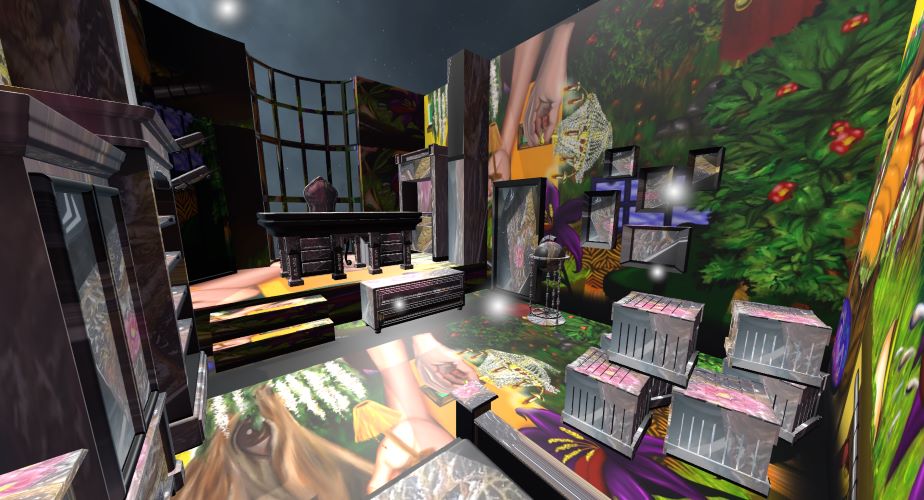
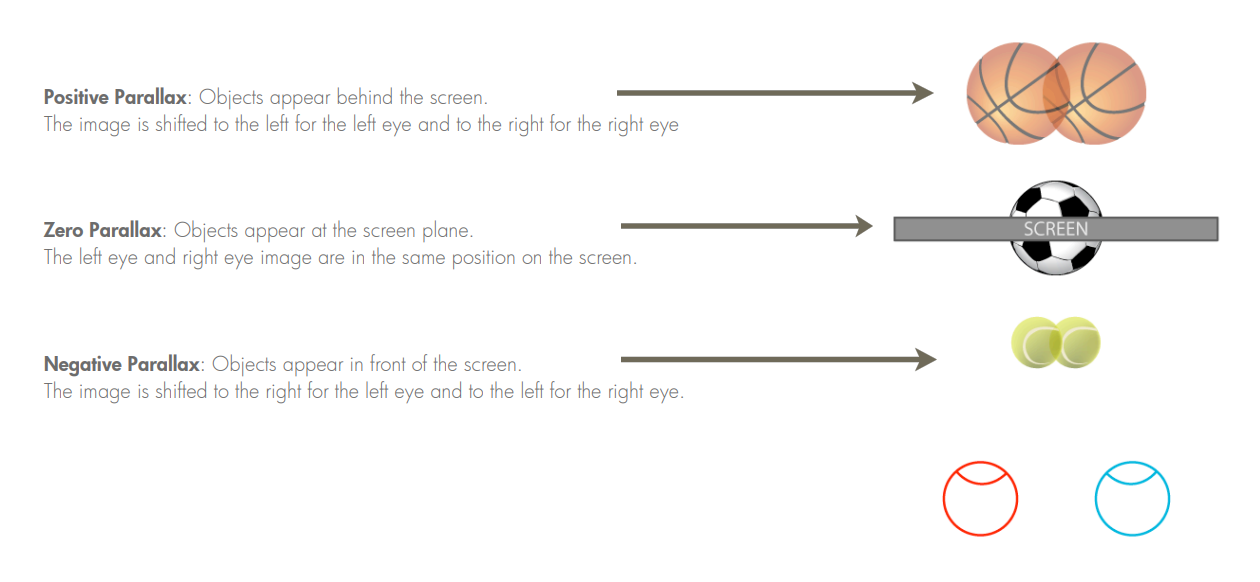
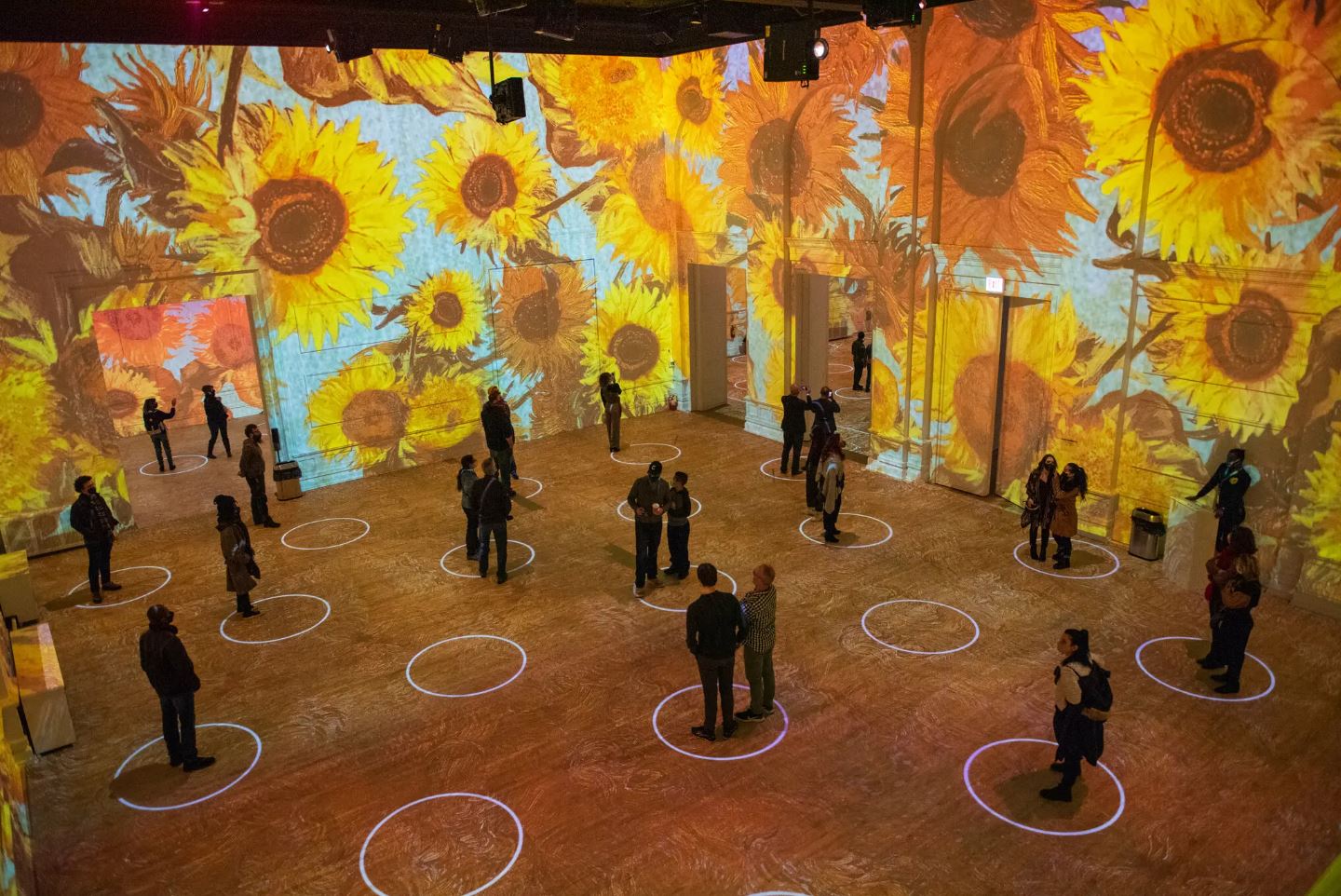
Leave a comment
Log in with itch.io to leave a comment.